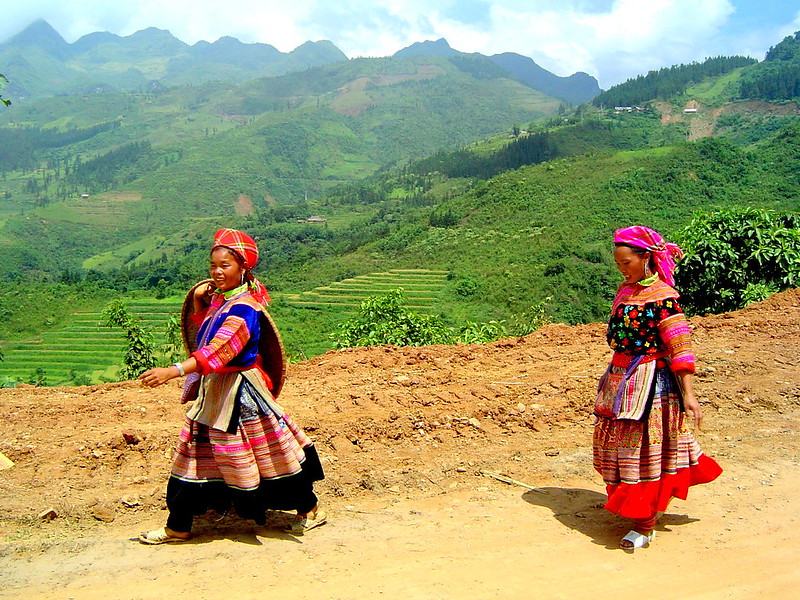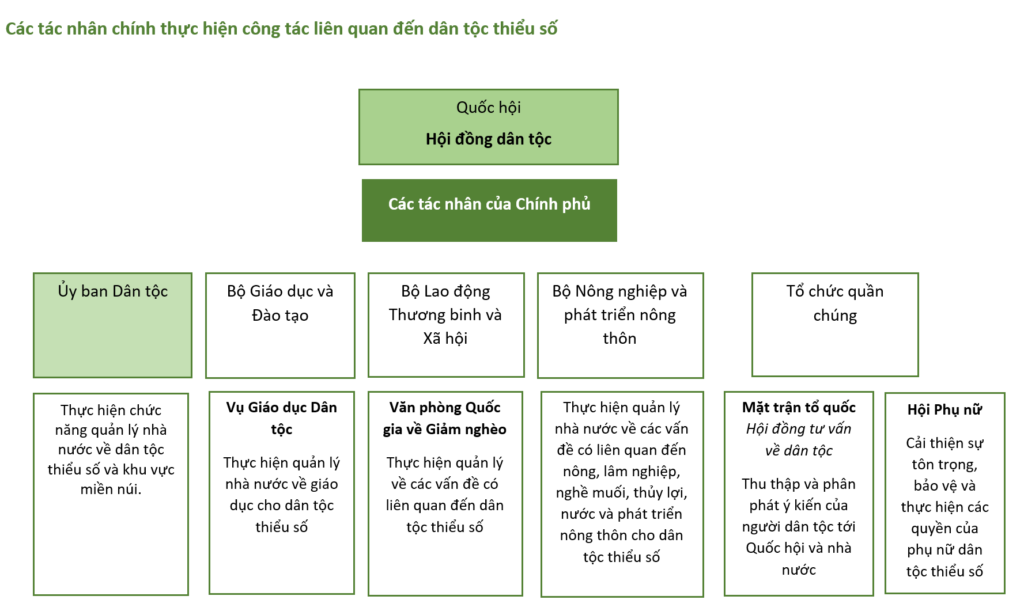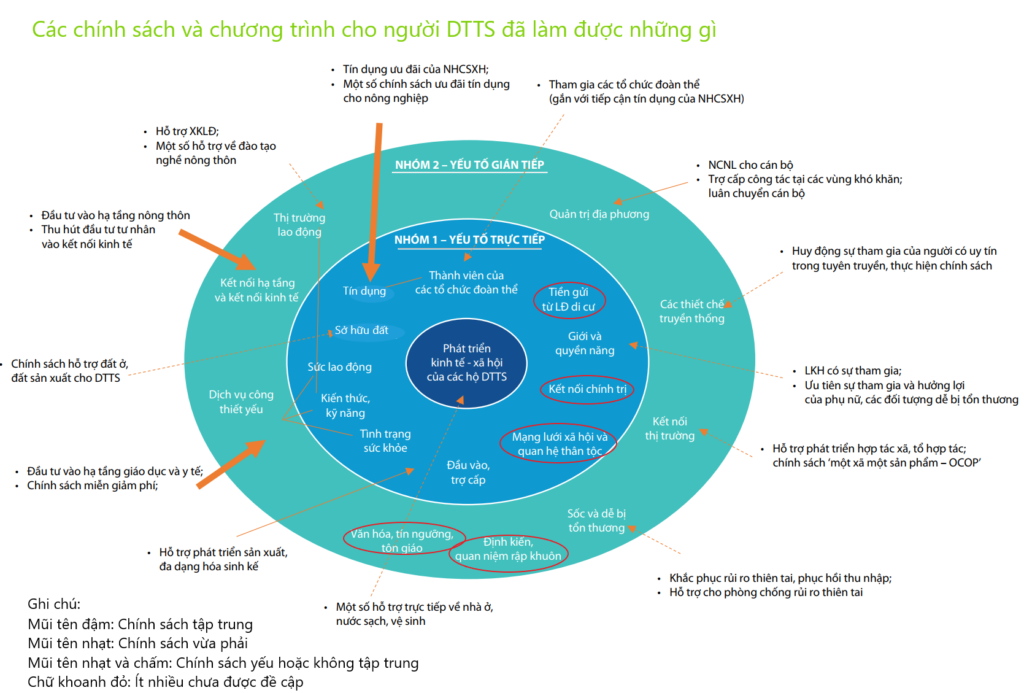Giới thiệu
Chính phủ Việt Nam công nhận 53 nhóm dân tộc thiểu số trên lãnh thổ Việt Nam.1 Một số tài liệu khác cho rằng tại Việt Nam có hơn 90 nhóm dân tộc, lên đến gần 10 triệu người, tương đương 10% dân số Việt Nam.2 Phần lớn các dân tộc thiểu số sống ở vùng sâu vùng xa và có hệ thống tín ngưỡng riêng gắn liền với đất đai.

Phụ nữ H’mông đi về từ chợ Bắc Hà. Ảnh do Philip Turner chụp. Được cấp phép theo CC BY-NC 2.0.
Kể từ những năm 1980, Chính phủ đã đưa ra một hệ thống chính sách nhằm đoàn kết các dân tộc thiểu số trong quá trình phát triển đất nước, với hơn 100 văn bản pháp lý được trên 10 cơ quan nhà nước ban hành.3 “Đề án tổng thể phát triển kinh tế – xã hội vùng đồng bào dân tộc thiểu số và miền núi giai đoạn 2021-2030” là văn bản thống nhất các chính sách này.4 Kế hoạch thực hiện đề án đã được Chính phủ ban hành vào năm 20205 và Chương trình mục tiêu quốc gia tương ứng hiện đang được soạn thảo. Tuy nhiên, vẫn còn những tranh luận về việc các chính sách này liệu có thể hiện được nhu cầu của người dân tộc thiểu số hay không.
Nguồn: Tạo bởi ODV. Được cấp phép theo CC BY-SA 4.0.
Triết lý phát triển
Hiến pháp Việt Nam công nhận quyền của người dân tộc thiểu số trong “sử dụng ngôn ngữ và chữ viết riêng, giữ gìn bản sắc dân tộc và nuôi dưỡng các phong tục, truyền thống và văn hóa tốt đẹp”. Mỗi người có “quyền tự chọn dân tộc, sử dụng tiếng mẹ đẻ và chọn ngôn ngữ để giao tiếp”.
Triết lý chính trong cách tiếp cận của Chính phủ để phát triển các dân tộc thiểu số vẫn không thay đổi kể từ năm 1992: “Bình đẳng, đoàn kết, tương trợ giúp đỡ lẫn nhau và phát triển toàn diện”.6 Chính sách hiện nay kêu gọi phát triển chính trị, kinh tế xã hội và văn hóa một cách toàn diện ở khu vực miền núi.7 Các lĩnh vực được ưu tiên bao gồm phát triển giao thông và cơ sở hạ tầng, xóa đói giảm nghèo, bảo vệ môi trường, phát triển nguồn nhân lực và văn hóa và phát triển cộng đồng dựa vào nội lực.8
Về nguyên tắc, cần phải tham vấn ý kiến của người dân tộc thiểu số trong quá trình xây dựng và hoạch định chính sách, nhưng các quy trình này không dễ tiếp cận được đến với tất cả các dân tộc thiểu số.
Các mục tiêu phát triển gắn với Mục tiêu phát triển bền vững (SDGs)
Ủy ban Dân tộc (CEMA)9 đã xác định các mục tiêu cụ thể nhằm đạt được SDGs.10 Tuy nhiên, nghiên cứu11 cho thấy những mục tiêu này khá tham vọng để đạt được. Cuộc điều tra thực trạng tình hình kinh tế xã hội của 53 dân tộc thiểu số Việt Nam 2019 (với kết quả dự kiến vào năm 2020) có thể cung cấp thêm những thông tin cập nhật để đánh giá.
Các gói chính sách chủ yếu
CEMA là cơ quan cấp bộ, đầu mối chịu trách nhiệm quản lý nhà nước về các vấn đề dân tộc ở Việt Nam. CEMA có mạng lưới các đơn vị trực thuộc ở hầu hết các tỉnh và các khu vực chiến lược về địa lý hoặc khu vực có dân số người dân tộc thiểu số từ 5.000 người trở lên. CEMA có cơ quan đại diện xuống tới cấp huyện.12 Cơ quan cấp nhà nước yêu cầu có đại diện tối thiểu là người dân tộc. Tuy nhiên, ở cấp xã, phân tích định tính chỉ ra rằng mặc dù có khá nhiều người dân tộc thiểu số tham gia, hầu hết các vị trí chủ chốt đều do người Kinh nắm giữ do trình độ chuyên môn cao hơn. Điều này có thể khiến các dân tộc thiểu số gặp bất lợi về khả năng tiếp cận các nguồn lực có sẵn từ các chính sách và hỗ trợ bên ngoài khác tại các xã hoặc thôn, cũng như hạn chế tiếng nói của họ.13
Chính sách gần đây nhất của Chính phủ dành cho các dân tộc thiểu số, được ban hành năm 2016, là “Quyết định về các chính sách đặc thù hỗ trợ phát triển kinh tế xã hội vùng dân tộc thiểu số và miền núi giai đoạn 2017-2020”.14 Ngoài ra, một loạt các Chương trình Mục tiêu Quốc gia về Giảm nghèo đã được triển khai, trong đó người dân tộc thiểu số là nhóm hưởng lợi chính (Chương trình 13415, Chương trình 135 giai đoạn 116 và giai đoạn 217, Chương trình 30a18 và Chương trình giảm nghèo bền vững 2016-202019). Gần đây, Chương trình mục tiêu Quốc gia xây dựng nông thôn mới cũng đề cập đến các dân tộc thiểu số ở vùng sâu vùng xa. Mục tiêu tổng thể của các chính sách này là thúc đẩy giảm nghèo bền vững và thu hẹp khoảng cách giữa các nhóm dân tộc và các vùng khác nhau của đất nước trong khi bảo vệ và giữ gìn văn hóa và phong tục dân tộc.
Các chính sách và chương trình của Chính phủ bao trùm một loạt các chủ đề:
- Sinh kế và giảm nghèo: chuyển các cộng đồng từ lối sống du canh du cư truyền thống sang định canh định cư, giao đất lâm nghiệp, tín dụng và trợ cấp.
- Phát triển nguồn nhân lực: miễn học phí, phát triển y tế dự phòng và cải thiện dinh dưỡng, thúc đẩy bình đẳng giới, khuyến khích lãnh đạo là người dân tộc trong cộng đồng và tại chính quyền các cấp
- Phát triển văn hóa: xây dựng nhà văn hóa thôn, thương mại hóa sản phẩm truyền thống, xem xét lại tài sản văn hóa.
- Phát triển cơ sở hạ tầng: xây dựng cơ sở hạ tầng thiết yếu bao gồm trường học, trạm y tế, đường xá, cầu cống, lưới điện, công trình thủy lợi, chợ bán buôn và bán lẻ, hệ thống thông tin liên lạc.
- Ứng dụng khoa học và công nghệ: ứng dụng công nghệ khoa học, đặc biệt là công nghệ thông tin, truyền thông, nâng cao năng lực (học trực tuyến, thư viện điện tử, v.v.).
Những hỗ trợ này đã mang đến một số cải thiện về mức sống ở các vùng dân tộc thiểu số, đáng chú ý về: kết nối giao thông, tiếp cận các dịch vụ công cộng (giáo dục và y tế), điều kiện nhà ở và tiếp cận các tiện ích công cộng (điện, nước sạch). Tuy nhiên, không có nhiều tiến bộ trong hỗ trợ sản xuất, nâng cao năng lực, phát triển văn hóa, phát huy tiếng nói và tăng sự tham gia của người dân tộc thiểu số vào phát triển cộng đồng.20 Chẳng hạn, văn hóa và lịch sử dân tộc Kinh vẫn chiếm ưu thế trong sách giáo khoa chính thống, các sách này chỉ được in bằng tiếng Việt.21 Các dự án xây dựng đập quy mô lớn và nông nghiệp hàng hóa gây ra tác động đáng kể đến hệ sinh thái rừng cùng với việc phân bổ lại đất đai đã đẩy người dân tộc thiểu số từ lối sống dựa vào rừng sang định canh nông nghiệp và sản xuất nông lâm nghiệp. Cách tiếp cận trong việc phân bổ đất đã bỏ qua tầm quan trọng của rừng cộng đồng trong thực thành tôn giáo và truyền thống của người dân tộc thiểu số.22 Các tổ chức tài trợ, cũng như Chính phủ, đã bày tỏ quan ngại về các chương trình này như: được thực hiện từ trên xuống,23 không dựa trên sự hiểu biết đầy đủ về văn hóa và tôn giáo dân tộc thiểu số,24 được xây dựng mà không có sự tham khảo ý kiến đầy đủ với các đại diện dân tộc thiểu số,25 chồng chéo về nội dung,26 thực hiện không đầy đủ và thiếu hiệu quả. Các nhà phê bình khác cho rằng các chương trình mang tính trợ cấp này không giúp cho các dân tộc thiểu số có quyền tự quyết.27,28 Vẫn còn khoảng cách lớn về thu nhập và cơ hội giữa các dân tộc thiểu số và đa số người Kinh, đây là mục tiêu mà Chính phủ nhắm đến để giải quyết.29
Nguồn: Ngân hàng thế giới. 2019. “Các yếu tố ảnh hưởng đến phát triển kinh tế xã hội của dân tộc thiểu số ở Việt Nam”.
Đối với các dân tộc thiểu số, các chương trình này có thể có gây ảnh hưởng đến thực tế hàng ngày. Đại dịch COVID-19 đã làm rõ nét những hệ quả này. Ví dụ, sự phụ thuộc lớn vào sản xuất nông nghiệp và ít khả năng tiếp cận các lợi ích chính sách sẽ hạn chế khả năng phục hồi của các cộng đồng dân tộc thiểu số sau những cú sốc. Đại dịch đã khiến thương mại nông nghiệp chậm lại 30và việc làm phi chính thức biến mất,31 dẫn đến tình trạng mất an ninh lương thực và nghèo đói đột ngột sẽ gây khó khăn cho người dân tộc thiểu số. Ngoài ra, khoảng cách số giữa nhóm dân tộc thiểu số và nhóm dân tộc đa số đang bị khuếch đại lên do sự phụ thuộc lớn của Chính phủ vào Internet và các công cụ kỹ thuật số để duy trì công việc, kinh doanh và giáo dục, cùng các biện pháp khác để ứng phó với COVID-19.
References
- 1. Chính phủ Việt Nam sử dụng cụm từ “người dân tộc thiểu số”, thay vì “người bản địa”, mặc dù đã bỏ phiếu ủng hộ Tuyên bố của Liên hợp quốc về “Quyền của người bản địa”.
- 2. Hiệp ước người bản địa châu Á. 2014. “Tổng quan về thực trạng của người bản địa ở châu Á”. Truy cập tháng 4 năm 2020.
- 3. Quốc hội nước Cộng hòa xã hội chủ nghĩa Việt Nam (cổng thông tin trực tuyến). “Góc nhìn đại biểu: Thúc đẩy phát triển toàn diện vùng dân tộc thiểu số”. Truy cập tháng 4 năm 2020.
- 4. Quốc hội Việt Nam. 2019. “Nghị quyết 88/2019 /QH14 phê duyệt Đề án tổng thể phát triển kinh tế xã hội khu vực miền núi và dân tộc thiểu số 2021-2030”. Truy cập tháng 4 năm 2020.
- 5. Cộng hòa xã hội chủ nghĩa Việt Nam. 2019. “Nghị quyết 12/NQ-CP về triển khai thực hiện Đề án tổng thể phát triển kinh tế xã hội khu vực miền núi và dân tộc thiểu số 2021-2030”. Truy cập tháng 4 năm 2020.
- 6. Cộng hòa xã hội chủ nghĩa Việt Nam. 2013. “Hiến pháp.” Truy cập tháng 4 năm 2020.
- 7. Cộng hòa xã hội chủ nghĩa Việt Nam. 2011. “Nghị định 05/2011/ND-CP của Thủ tướng Chính phủ về công tác dân tộc”. Truy cập tháng 4 năm 2020.
- 8. Cộng hòa xã hội chủ nghĩa Việt Nam. 2013. “Quyết định 449/QĐ-TTg của Thủ tướng Chính phủ phê duyệt chiến lược công tác dân tộc đến năm 2020”. Truy cập tháng 4 năm 2020.
- 9. CEMA là cơ quan chính phủ cấp bộ, có chức năng quản lý các dân tộc thiểu số và khu vực miền núi.
- 10. Cộng hòa xã hội chủ nghĩa Việt Nam. 2015. “Quyết định 1557/QĐ-TTg phê duyệt một số chỉ tiêu thực hiện các Mục tiêu phát triển Thiên niên kỷ đối với đồng bào dân tộc thiểu số gắn với Mục tiêu phát triển bền vững sau năm 2015”. Truy cập tháng 4 năm 2020.
- 11. TS. Phùng Đức Tùng, TS. Nguyễn Việt Cường, TS. Nguyễn Cao Thịnh, Nguyễn Thị Nhung và Tạ Thị Khánh Vân (2017), “Tổng quan thực trạng kinh tế xã hội – Dựa trên kết quả phân tích số liệu điều tra thực trạng kinh tế xã hội của 53 dân tộc thiểu số năm 2015”, Truy cập tháng 5 năm 2018.
- 12. Cộng hòa xã hội chủ nghĩa Việt Nam. 2015. “Nghị định số 53/2004/NĐ-CP ngày 18/2/2004 về kiện toàn tổ chức bộ máy làm công tác dân tộc thuộc Uỷ ban nhân dân các cấp.” Truy cập tháng 5 năm 2020.
- 13. Ngân hàng Thế giới. 2019. “Các yếu tố ảnh hưởng đến sự phát triển kinh tế-xã hội của dân tộc thiểu số tại Việt Nam”. Truy cập tháng 4 năm 2020.
- 14. Cộng hòa xã hội chủ nghĩa Việt Nam. 2016. “Quyết định số 2085/QĐ-TTg của Thủ tướng Chính phủ phê duyệt các chính sách đặc thù hỗ trợ phát triển kinh tế xã hội vùng dân tộc thiểu số và miền núi giai đoạn 2017-2020”. Truy cập tháng 4 năm 2020.
- 15. Cộng hòa xã hội chủ nghĩa Việt Nam. 2004. “Quyết định 134/2004/QĐ-TTg của Thủ tướng chính phủ về một số chính sách hỗ trợ đất sản xuất, đất ở, nhà ở và nước sinh hoạt cho hộ đồng bào dân tộc thiểu số nghèo, đời sống khó khăn”. Truy cập tháng 4 năm 2020.
- 16. Cộng hòa xã hội chủ nghĩa Việt Nam. 1998. “Quyết định số 135/1998/QĐ-TTg của Thủ tướng Chính phủ về Chương trình phát triển kinh tế xã hội các xã đặc biệt khó khăn miền núi và vùng sâu vùng xa”. Truy cập tháng 4 năm 2020.
- 17. Cộng hòa xã hội chủ nghĩa Việt Nam. 2006. “Quyết định số 07/2006/QĐ-TTg của Thủ tướng Chính phủ về Chương trình phát triển kinh tế xã hội các xã đặc biệt khó khăn vùng đồng bào dân tộc và miền núi, giai đoạn 2006-2010”. Truy cập tháng 4 năm 2020.
- 18. Cộng hòa xã hội chủ nghĩa Việt Nam. 2008. “Nghị quyết số 30a/2008/NQ-CP về chương trình hỗ trợ giảm nghèo nhanh và bền vững đối với 61 huyện nghèo”. Truy cập tháng 4 năm 2020.
- 19. Cộng hòa xã hội chủ nghĩa Việt Nam. 2016. “Quyết định 1722/QĐ-TTg phê duyệt chương trình mục tiêu quốc gia Giảm nghèo bền vững giai đoạn 2016-2020”. Truy cập tháng 4 năm 2020.
- 20. Ngân hàng Thế giới. 2019. “Các yếu tố ảnh hưởng đến sự phát triển kinh tế-xã hội của dân tộc thiểu số tại Việt Nam”. Truy cập tháng 4 năm 2020.
- 21. Baulch, Bob; Trương Thị Kim Chuyên; Haughton, Dominique; Haughton, Jonathan. 2002. “Sự phát triển của dân tộc thiểu số ở Việt Nam trên quan điểm kinh tế xã hội”. Loạt bài bản thảo nghiên cứu chính sách; Số WPS 2836. Washington, DC: Ngân hàng Thế giới. Truy cập tháng 4 năm 2020.
- 22. CIRUM. 2011. “Vai trò của luật tục và tập quán trong quản lý và sử dụng tài nguyên rừng và nước.” Truy cập tháng 4 năm 2020.
- 23. Hải-Anh Đặng. 2012. “Việt Nam: Khoảng cách nghèo đói ngày càng lớn đối với các dân tộc thiểu số” trong Gillette Hall and Harry Patrinos. (Eds.) “Người bản địa, Nghèo đói và Phát triển ”. Nhà xuất bản Đại học Cambridge, sắp ra mắt. Truy cập tháng 4 năm 2020.
- 24. Quỹ Hiệp ước người bản địa châu Á. 2015. “Người bản địa ở Asean: Việt Nam”. Truy cập tháng 4 năm 2020.
- 25. CEMA, UNDP. 2012. “Tình hình và khuyến nghị chính sách đối với việc quản lý và sử dụng đất đai tại các vùng dân tộc thiểu số và miền núi – Báo cáo tóm tắt.” Truy cập tháng 4 năm2020.
- 26. Benjamin, D., Brandt, L., McCaig, B. và Lê Hoa, N. 2018. “Tham gia vào chương trình phân phối đất có mục tiêu và kết quả của hộ của gia đình: bằng chứng từ Việt Nam.” Tạp chí Kinh tế hộ gia đình, 16(1), trang. 41-74. Truy cập tháng 4 năm 2020.
- 27. TS. Phùng Đức Tùng, TS. Nguyễn Việt Cường, TS. Nguyễn Cao Thịnh, Nguyễn Thị Nhung và Tạ Thị Khánh Vân (2017), “Tổng quan thực trạng kinh tế xã hội – Dựa trên kết quả phân tích số liệu điều tra thực trạng kinh tế xã hội của 53 dân tộc thiểu số năm 2015”, Truy cập tháng 5 năm 2018.
- 28. Quỹ Hiệp ước người bản địa châu Á. 2015. “Người bản địa ở Asean: Việt Nam”. Truy cập tháng 4 năm 2020.
- 29. Kozel, Valerie J.. 2014. “Khởi đầu tốt, nhưng chưa phải đã hoàn thành: tiến trình và những thách thức mới về về giảm nghèo của Việt Nam”. Washington, DC ; Nhóm ngân hàng thế giới. Truy cập tháng 4 năm 2020.
- 30. Vietnam News. 2020. “Giá nông sản xuất khẩu sụt giảm thời Covid-19” . Truy cập tháng 4 năm 2020.
- 31. Tin tức hải quan. 2020. “Hàng triệu người đối mặt với tình trạng mất việc làm do tác động của COVID-19 lên thị trường việc làm”. Truy cập tháng 4 năm 2020.



